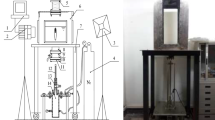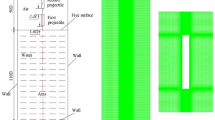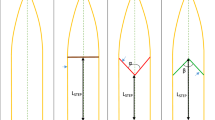Abstract
High-speed oblique water entry is an interesting subject, many physical aspects of which remain unknown up to now. Among high-speed air-to-water projectiles, the supercavitating cylindrical-cone (SCC) ones have economic and operational advantages over the other types. However, maintaining stability of the SCC projectiles inside the cavity at shallow entry angles is a challenging issue from both practical and design-related points. The first section of the present study proposes a novel and unique scheme of air-to-water supercavitating projectile design which is called the supercavitating stepped cylindrical-cone (SSCC) projectile. The SSCC scheme is analyzed numerically to investigate the projectile stability improvement at shallow entry angles. The 6DOF dynamics of the SSCC projectile are investigated using the Star-CCM+ commercial code in the presence of three phases of air, water and vapor in a three-dimensional and transient model. Accuracy of numerical results and the model’s ability to simulate the physical phenomena of water entry is validated using experimental results from the literature, and both are in good agreement. In the present study, the high-speed oblique water entry dynamics of the SSCC projectile are investigated for five certain entry angles varying from 10° to 60°. The results show that the SSCC projectile faces intensive unstabilizing forces in the water entry process which leads to a heavy pitching moment and, hence, intensive angular velocity (\( \dot{\gamma } \)) on the projectile. This study also proves that the presence of step enhances the projectile stability in the entry process. The present study shows that, based on their geometry and mass characteristics, each SSCC projectile is capable of withstanding instability up to a critical value of the angular velocity (\( \dot{\gamma }_{\text{Cr}} \)). Therefore, projectile stability inside the cavity can be achieved when the value of maximum angular velocity (\( \left| {\dot{\gamma }} \right|_{\hbox{max} } \)) experienced by the projectile is lower that \( \dot{\gamma }_{\text{Cr}} \) (i.e., \( \left| {\dot{\gamma }} \right|_{\hbox{max} } < \dot{\gamma }_{\text{Cr}} \)). The results of this study also show that \( \left| {\dot{\gamma }} \right|_{\hbox{max} } \) is inversely correlated with the \( \gamma \), and that it follows a simple equation which is proposed in this study. Therefore, projectile stability inside the cavity can also be practically achieved by adjusting the shooting mechanism at an angle higher than the minimum stable entry angle (\( \gamma_{\hbox{min} } \)). This study also proposes an effective numerical approach to evaluate \( \gamma_{\hbox{min} } \) of a supercavitating projectile. It should be noted that determining the value of \( \gamma_{\hbox{min} } \) is an important factor from both a practical and design-related points of view.





















Similar content being viewed by others
Abbreviations
- F :
-
External force vector exerted to the projectile
- fn b :
-
Force applied to the projectile surface number n, along vector b (Fig. 5)
- g :
-
Earth’s gravitational acceleration vector
- I :
-
Moment of inertia
- m n :
-
Pitching moment applied to the projectile surface number n, along z (Fig. 5)
- m p :
-
Projectile mass
- \( \dot{m}_{\text{qk}} \) :
-
Mass transfer rate from phase q to phase k
- M :
-
Hydrodynamic moment vector exerted to the projectile
- p :
-
Static pressure
- \( p_{\text{sat}} \) :
-
Saturation pressure
- \( p_{\infty } \) :
-
Ambient pressure
- R :
-
Cavity radius
- V :
-
Projectile velocity vector
- \( \left( {V_{X} ,V_{Y} , V_{Z} } \right) \) :
-
Projectile velocity component along the inertial coordinate system axes
- \( \left( {V_{x} ,V_{y} , V_{z} } \right) \) :
-
Projectile velocity component along the body coordinate system axes
- \( \left( {X,Y,X} \right) \) :
-
Position of the center of mass of the projectile along the inertial coordinate system axes (Fig. 4)
- \( \left( {x,y,z} \right) \) :
-
Position of the center of mass of the projectile along the body coordinate system axes (Fig. 4)
- (\( \gamma ,\varphi ,\psi \)):
-
The rotational angles of projectile with respect to the coordinate axis
- \( \dot{\gamma } \) :
-
Projectile angular velocity
- θ :
-
Projectile velocity angle with respect to the water surface
- \( \alpha \) :
-
Angle of attack
- \( \omega \) :
-
Angular velocity
- \( \alpha_{\text{l}} ,\alpha_{\text{v}} ,\alpha_{\text{a}} \) :
-
Volume fraction of liquid, vapor and air phases
- \( \rho_{\text{l}} ,\rho_{\text{v}} ,\rho_{\text{a}} \) :
-
Density of liquid, vapor and air phases
- \( \mu \) :
-
Dynamic viscosity
- \( \rho_{\text{w}} \) :
-
Water density
References
Bodily KG, Carlson SJ, Truscott TT (2014) The water entry of slender axisymmetric bodies. Phys Fluids 26(7):072108
Truscott TT, Epps BP, Belden J (2014) Water entry of projectiles. Annu Rev Fluid Mech 46:355–378
Rammics. [Available from: http://www.northropgrumman.com/capabilities/RAMICS/page/default.aspx
Hou Z, Sun T, Quan X, Zhang G, Sun Z, Zong Z (2018) Large eddy simulation and experimental investigation on the cavity dynamics and vortex evolution for oblique water entry of a cylinder. Appl Ocean Res 81:76–92
Mirzaei M, Alishahi MM, Eghtesad M (2015) High-speed underwater projectiles modeling: a new empirical approach. J Braz Soc Mech Sci Eng 37(2):613–626
Kulkarni SS, Pratap R (2000) Studies on the dynamics of a supercavitating projectile. Appl Math Model 24(2):113–129
Hrubes J (2001) High-speed imaging of supercavitating underwater projectiles. Exp Fluids 30(1):57–64
McCoy R (1999) Modern exterior ballistics: the launch and flight dynamics of symmetric projectiles. Schiffer Pub, Atglen
Truscott T, Techet A, Beal D (2009) Shallow angle water entry of ballistic projectiles. In: Ceccio S (ed) Proceedings of the Cav2009. International symposium on cavitation. Art. 100
Derakhshanian MS, Haghdel M, Alishahi MM, Haghdel A (2018) Experimental and numerical investigation for a reliable simulation tool for oblique water entry problems. Ocean Eng 160:231–243
Rabiee A, Alishahi M, Emdad H, Saranjam B (2011) Experimental investigation of bounce phenomenon. Sci Iran 18(3):416–422
Harkins T, Steves H, Goeller J (2001) Inventors; US Secretary of Navy, assignee. Supercavitating water-entry projectile. United States
Shi H-H, Itoh M, Takami T (2000) Optical observation of the supercavitation induced by high-speed water entry. J Fluids Eng 122(4):806–810
Weiland C, Vlachos PP (2012) Time-scale for critical growth of partial and supercavitation development over impulsively translating projectiles. Int J Multiphase Flow 38(1):73–86
Guo Z-T, Zhang W, Cong W (2012) Experimental and theoretical study on the high-speed horizontal water entry behaviors of cylindrical projectiles. J Hydrodyn Ser B 24(2):217–225
Zhao C, Wang C, Wei Y, Zhang X, Sun T (2016) Experimental study on oblique water entry of projectiles. Mod Phys Lett B 30(28):1650348
Chen T, Huang W, Zhang W, Qi Y, Guo Z (2019) Experimental investigation on trajectory stability of high-speed water entry projectiles. Ocean Eng 175:16–24
Jiang C-X, Shuai Z-J, Zhang X-Y, Li W-Y, Li F-C (2016) Numerical study on the transient behavior of water-entry supercavitating flow around a cylindrical projectile influenced by turbulent drag-reducing additives. Appl Therm Eng 104:450–460
Nguyen V-T, Vu D-T, Park W-G, Jung C-M (2016) Navier–Stokes solver for water entry bodies with moving Chimera grid method in 6DOF motions. Comput & Fluids 140:19–38
Iranmanesh A, Passandideh-Fard M (2017) A three-dimensional numerical approach on water entry of a horizontal circular cylinder using the volume of fluid technique. Ocean Eng 130:557–566
Qi D, Feng J, Xu B, Zhang J, Li Y (2016) Investigation of water entry impact forces on airborne-launched AUVs. Eng Appl Comput Fluid Mech 10(1):473–484
Gao J, Chen Z, Wu W-T, Li X (2019) Numerical investigations on the water entry of cylindrical projectiles with different initial conditions. Appl Sci 9(9):1858
Chen C, Yuan X, Liu X, Dang J (2019) Experimental and numerical study on the oblique water-entry impact of a cavitating vehicle with a disk cavitator. Int J Naval Archit Ocean Eng 11(1):482–494
Yuan X, Chen C, Wang Y, Liu X (eds) (2017) On the cavity pressure during the water-entry of a supercavitating vehicle. OCEANS–Anchorage. IEEE
van der Aus der Wiesche S (2005) Numerical simulation of cavitation effects behind obstacles and in an automotive fuel jet pump. Heat Mass Transf 41(7):615–624
Passandideh-Fard M, Roohi E (2008) Transient simulations of cavitating flows using a modified volume-of-fluid (VOF) technique. Int J Comput Fluid Dyn 22(1–2):97–114
Hirt CW, Nichols BD (1981) Volume of fluid (VOF) method for the dynamics of free boundaries. J Comput Phys 39(1):201–225
Schnerr GH, Sauer J (eds) (2001) Physical and numerical modeling of unsteady cavitation dynamics. In: Fourth international conference on multiphase flow. ICMF New Orleans
Zwart PJ, Gerber AG, Belamri T (eds) (2004) A two-phase flow model for predicting cavitation dynamics. In: Fifth international conference on multiphase flow. Yokohama, Japan
Yu A, Tang Q, Zhou D (2019) Cavitation evolution around a NACA0015 hydrofoil with different cavitation models based on level set method. Appl Sci 9(4):758
Kiceniuk T (1954) An experimental study of the hydrodynamic forces acting on a family of cavity-producing conical bodies of revolution inclined to the flow. Cal.Inst.Tech. Hydrodynamics Lab. Report No.E-12.17. 1954
May A (1975) Water entry and the cavity-running behavior of missiles. Final Technical Report. NAVSEA Hydroballistics Advisory Committee. Silver Spring, MD
Author information
Authors and Affiliations
Corresponding author
Additional information
Technical Editor: Erick Franklin, Ph.D.
Publisher's Note
Springer Nature remains neutral with regard to jurisdictional claims in published maps and institutional affiliations.
Rights and permissions
About this article
Cite this article
Akbari, M.A., Mohammadi, J. & Fereidooni, J. A dynamic study of the high-speed oblique water entry of a stepped cylindrical-cone projectile. J Braz. Soc. Mech. Sci. Eng. 43, 2 (2021). https://doi.org/10.1007/s40430-020-02727-2
Received:
Accepted:
Published:
DOI: https://doi.org/10.1007/s40430-020-02727-2




